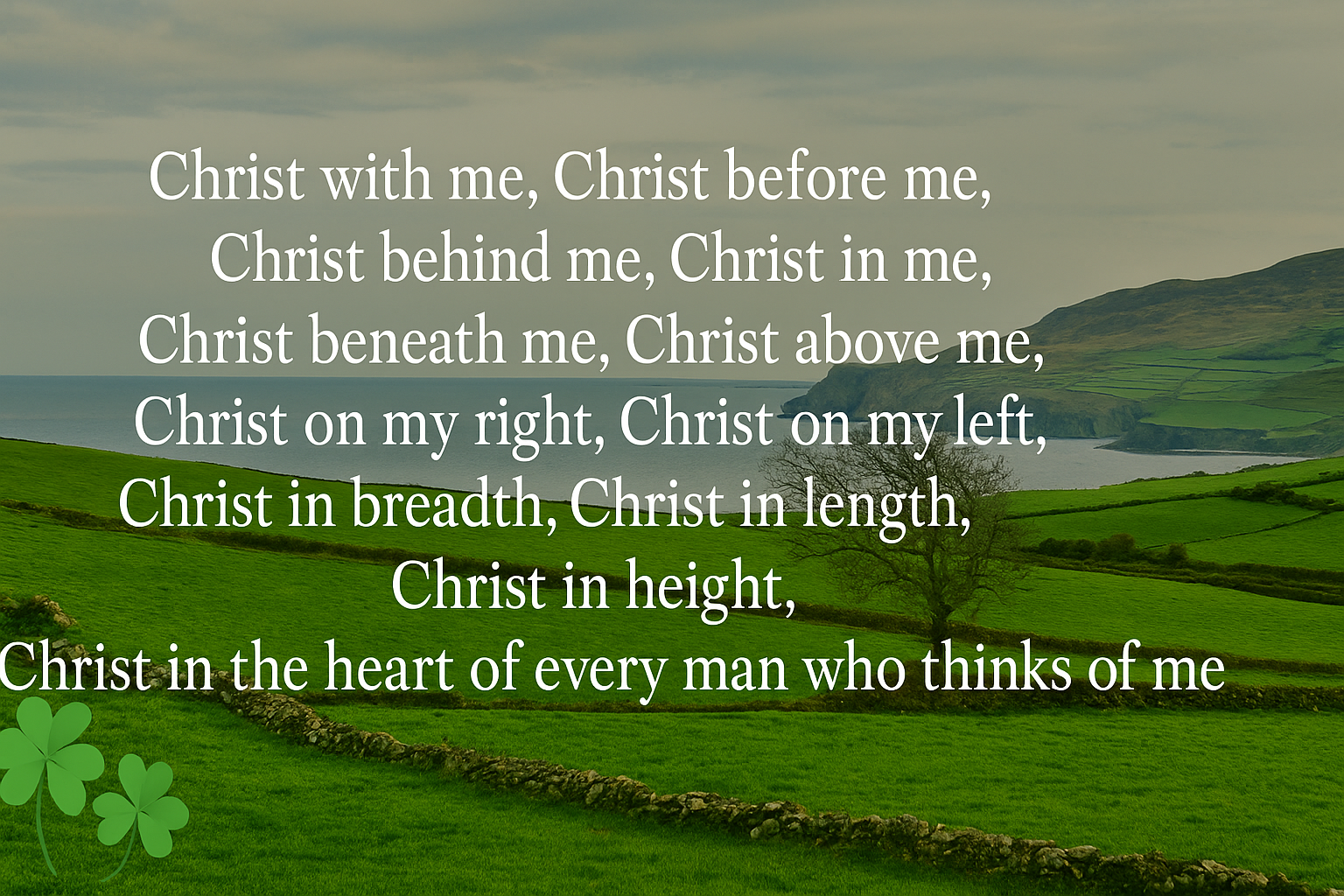For me, the best part of growing up in a large Irish Catholic family was the gatherings on St. Patrick’s Day. Corned beef, cabbage, and soda bread were reserved for every March 17, as were embellished stories that family members would tell for hours on end. I soon realized the Irish tradition of exaggerated storytelling probably explains why I was misled about St. Patrick’s life. So much of what I heard was untrue (he did not drive snakes out of Ireland), and I missed learning much about his exploits that would have been a great example to a young me.
There are so many amazing facts about the life and faith of St. Patrick that we do ourselves a disservice if we don’t learn more before the next round of parades and parties. So, what is St. Patrick’s Day supposed to be celebrating, and who is the person for whom it is named?
What Is St. Patrick’s Day?
Though he was never canonized (made a saint) by the Catholic church, tradition holds that Patrick was the patron saint of Ireland. On March 17 each year, the anniversary of his death, Catholic churches, the Church of Ireland, and Eastern Orthodox churches celebrate this day as a major feast day. Parishioners attend mass and abstain from excess work on such a day.
Regardless of your denomination, you can celebrate St. Patrick’s Day in the way it was first intended. The idea was to honor Patrick for his lifelong sacrifice to preaching the gospel, and honor God who raised up Patrick from a dire situation to become a blessing to the people of Ireland. The more we hear his story, the more we understand that God never leaves His children and has a special plan for each one of us.
Who Was Saint Patrick?
According to History.com, Patrick was born in Roman Britain (likely Scotland), not in Ireland, to wealthy parents around 385 AD. When he was 16, he was taken captive by marauders who were looting his family’s estate. His captors took him with them to Ireland and enslaved him, forcing him to tend cattle on a mountain in what is now Northern Ireland.
LibraryIreland.com shares what young Patrick’s faith looked like at that time, and how it affected him:
“And there the Lord opened the sense of my unbelief that I might at last remember my sins and be converted with all my heart to the Lord my God… I used to stay out in the forests and on the mountain and I would wake up before daylight to pray in the snow, in icy coldness, rain, and I used to feel neither ill nor any slothfulness, because, as I now see, the Spirit was burning within me.”
After six years in Ireland, Patrick had a dream in which he was told to return to his birthplace. He escaped back to his home country by begging passage on a boat headed east, and then trekked back to his family home. He believed that God was calling him to the priesthood so he studied for ordination as a Catholic priest for the next 15 years. He had another dream in which an angel said he needed to go back to Ireland, so he went back to the land of his captivity to follow God’s call to spread the gospel.
Though St. Patrick was not the first to introduce Christianity to Ireland (and mystery surrounds who did), his mission was to minister to the Christians already living in Ireland, and to witness to unbelievers. The latter proved to be a significant challenge for Patrick—as well as for Palladius, a bishop sent by the pope in Rome to evangelize Ireland.
Before the arrival of these two men, the Irish people's spiritual life was rooted in Celtic polytheism. They worshiped many gods, celebrated through rituals and seasonal festivals. In its 150 kingdoms, chieftains called on spiritual leaders known as Druids to serve as priests and intermediaries between the gods and the people. The religion placed a strong emphasis on nature worship and belief in spirits from other realms.
Patrick drew upon his knowledge of Irish culture—much of it learned during his six years in slavery—to adapt the Christian message in a way that resonated with the people. For example, because the sun was a powerful symbol in their belief system, he combined the image of the Christian cross with a circle representing the sun, creating what is now known as the Celtic Cross. There is also a tradition that says that St. Patrick explained the Trinity through the use of a shamrock, a groundcover plant that thrives in Ireland’s climate. He didn’t compromise the message of the gospel–he just learned how to get through to the people.
How Was St. Patrick Instrumental in the Growth of Christianity in Ireland?
St. Patrick is credited with spurring the growth of Christianity that continued for more than a millennium in Ireland. LibraryIreland.com says that “...the fervour of his soul carried him through nearly 30 years of work in Ireland, work which left an impress on nearly every part of the country. He says that he baptized many thousands and ordained clergy everywhere, ‘not demanding from any even the price of my shoe; sons and daughters of Scotic (Irish) chieftains becoming monks and virgins of Christ.'”
St. Patrick established numerous churches and trained countless clergy and monks before he died in 461. In the book Always Ireland, writer Jack Kavanaugh says, “Using all his skills as a storyteller and dealmaker, Patrick cleverly adapted many of the old Irish ways to spread his Christian message to this last outpost of pagan Europe…His powers of persuasion were key to converting chieftains and kings and to quelling intrigue and conflict amidst poets and Druids." After his passing, Irish monasticism grew quickly– as monasteries were built for training, art and missionary work. Monks would spend their lives carefully preserving important texts, while developing a unique style of Christian art. We are likely familiar with the best example– Irish Book of Kells–which is an illustrated book of the four Gospels as well as some other writings. Monks then became missionaries in subsequent centuries, spreading the good news of Jesus Christ to foreign lands.
Biblical Meaning behind Shamrocks and St. Patrick’s Day Symbols
There are three symbols that are often attributed to St. Patrick that can be associated with what we find in Scripture:
Shamrock–this would be a three-leaf clover variety, since a four-leaf kind is associated with “luck” (something that we will not see in the Bible). But the story goes that St. Patrick, speaking to nature worshipers, picked up a shamrock and explained the “three-in-one” nature of Father, Son, and Holy Spirit. Similar to the Apostle Paul speaking in Greece to people who set up an altar to “an unknown god,” and used it as a means of starting discussion of the One True God who they could come to know (Acts 17).
Bishop’s crook—there were many shepherds in Ireland who could understand the value of a crook in their work with sheep. St. Patrick carried a crook with him. This would allow for object lessons surrounding all of the mentions of the Good Shepherd in the Bible, such as Psalm 23 and parables such as the lost sheep. His crook was actually called a Bishop’s “crozier” and was a symbol of authority, and his responsibility to teach and care for his “flock.”
Celtic Cross–as mentioned earlier, St. Patrick designed a cross superimposed on a circle that was supposed to symbolize the sun. This was a symbol used to explain our need for salvation and how Jesus’ sacrifice on a wooden cross accomplished that for us, leading us to a life of worship.
What Is St. Patrick’s Breastplate Prayer?

Also known as “The Lorica of St. Patrick,” the “Breastplate Prayer” is a prayer to act as spiritual defense against our enemy. In the article, “What are the Words of St. Patrick’s Breastplate Prayer”, Britt Mooney writes, “According to tradition and legend, Patrick composed and recited this prayer while traveling to speak with the Irish King Loegaire, who resisted the gospel and Patrick’s work. Some stories say Patrick and his companions prayed, and God supernaturally made them appear as a herd of deer to avoid capture.”
The prayer reads as follows:
“I arise today through a mighty strength, the invocation of the Trinity, through belief in the threeness, through confession of the oneness of the Creator of creation.
I arise today through the strength of Christ with his baptism,
through the strength of his crucifixion with his burial,
through the strength of his resurrection with his ascension,
through the strength of his descent for the judgment of doom.
I arise today through the strength of the love of cherubim
in obedience of angels, in the service of the archangels,
in hope of resurrection to meet with reward,
in prayers of patriarchs, in predictions of prophets,
in preaching of apostles, in faiths of confessors,
in innocence of holy virgins, in deeds of righteous men.
I arise today, through the strength of heaven:
light of sun, brilliance of moon, splendor of fire,
speed of lightning, swiftness of wind, depth of sea,
stability of earth, firmness of rock.
I arise today, through God's strength to pilot me:
God's might to uphold me, God's wisdom to guide me,
God's eye to look before me, God's ear to hear me,
God's word to speak for me, God's hand to guard me,
God's way to lie before me, God's shield to protect me,
God's host to secure me:
against snares of demons, against temptations of vices,
against inclinations of nature, against everyone who
shall wish me ill, afar and anear, alone and in multitude.
I summon today all these powers between me and these evils:
against every cruel and merciless power that may oppose my body and my soul, against incantations of false prophets,
against black laws of heathenry,
against false laws of heretics, against craft of idolatry,
against spells of witches and smiths and wizards,
against every knowledge that endangers man's body and soul.
Christ to protect me today
against poison, against burning,
against drowning, against wounding,
so that there may come abundance of reward.
Christ with me, Christ before me, Christ behind me, Christ in me,
Christ beneath me, Christ above me,
Christ on my right, Christ on my left,
Christ in breadth, Christ in length, Christ in height,
Christ in the heart of every man who thinks of me,
Christ in the mouth of every man who speaks of me,
Christ in every eye that sees me,
Christ in every ear that hears me.
I arise today through a mighty strength, the invocation of the Trinity, through belief in the threeness, through confession of the oneness of the Creator of creation.
Salvation is of the Lord. Salvation is of the Lord. Salvation is of Christ. May your salvation, Oh Lord, be ever with us.”
Various Christian denominations, especially Irish ones, will use the entire prayer in a service or just the bolded portion. The ancient hymn “I Bind Unto Myself Today,” written in the 8th century, shares the same tone and includes a portion of the Breastplate Prayer as bolded above.
Other St. Patrick's Day Prayers
St. Patrick was not a prolific writer, and we don’t have much more of his work to see. However, "The Breastplate Prayer" can lead us to Bible verses that can become prayers that we pray over ourselves and our families. For instance:
Most Merciful Creator of Us All,
Thank You that Your word tells us that You are always with us, and will never leave us or forsake us (Hebrews 13:5). Thank You that the angel of the Lord camps around those who fears him and delivers him (Psalm 34:7). Thank You for all the times in Scripture that we read that You are a shield for Your people, a fortress, a strong tower, and that Your might is unmatched (Psalm 18:2). Because of all of these truths, Abba Father, we can trust that You go before us into every situation and You provide for us in ways that give us confidence and peace. Thank you for your perpetual goodness towards us.
How Have St. Patrick’s Day Traditions Evolved?
In Ireland, St. Patrick’s Day began as a religious holiday and grew into a celebration of the Irish nation as well. Schools and businesses close and you’ll see many wearing green and displaying shamrocks as decor–a nod to the legend that St. Patrick taught about the Trinity by using the shamrock.
In the United States, only about 10 percent of the population claims Irish descent, but many will venerate the day with mass before other activities (if they participate in anything but honoring Patrick’s work on this day). In Ireland as in the United States and elsewhere, unfortunately St. Patrick’s Day has turned into a time of much drinking. Since the holiday happens during Lent–when many abstain from meat and alcohol–it’s seen as a “day off” and a time for alcohol and revelry. This of course is not true of all those who celebrate St. Patrick’s Day, but it is the reputation that has emerged. And of course, many who aren’t Irish or Christians will also celebrate the day.
So how should Christians celebrate St. Patrick’s Day? By learning the real life of St. Patrick, a life of deep and abiding faith–and ignoring the embellished stories. By not falling prey to temptation to celebrate as many do–with an emphasis on alcohol in excess. By celebrating In the way it was originally intended: a time to recognize and celebrate how God provided for St. Patrick to reach the people of Ireland with the gospel, and gratitude to God for the plans that He has for each of us. None of us knows how God will use the life we are living now for our ultimate good and for His glory, but we can be assured that as He loved and moved the heart of St. Patrick, He can surely do for us too.
Read More about St. Patrick's Day:
What Is St. Patrick's Day and Its Spiritual Meaning?
How Should Christians Celebrate St. Patrick's Day?
10 St. Patrick's Day Quotes and Blessings
First American St. Patrick's Day Celebration
What Is St. Patrick's Prayer?
What Can We Learn from the Life of St. Patrick?
The Story of St. Patrick: A Man of Towering Faith
Photo credit: ©GettyImages/Hakase
Mary Oelerich-Meyer is a Chicago-area freelance writer and copy editor who prayed for years for a way to write about and for the Lord. She spent 20 years writing for area healthcare organizations, interviewing doctors and clinical professionals and writing more than 1,500 articles in addition to marketing collateral materials. Important work, but not what she felt called to do. She is grateful for any opportunity to share the Lord in her writing and editing, believing that life is too short to write about anything else. Previously she served as Marketing Communications Director for a large healthcare system. She holds a B.A. in International Business and Marketing from Cornell College (the original Cornell!) When not researching or writing, she loves to spend time with her writer daughter, granddaughter, rescue doggie and husband (not always in that order).


.jpg)
